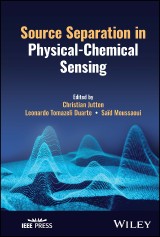Details

Source Separation in Physical-Chemical Sensing
IEEE Press 1. Aufl.
|
106,99 € |
|
| Verlag: | Wiley |
| Format: | |
| Veröffentl.: | 11.10.2023 |
| ISBN/EAN: | 9781119137290 |
| Sprache: | englisch |
| Anzahl Seiten: | 400 |
DRM-geschütztes eBook, Sie benötigen z.B. Adobe Digital Editions und eine Adobe ID zum Lesen.
Beschreibungen
<b>Source Separation in Physical-Chemical Sensing</b> <p><b>Master advanced signal processing for enhanced physical and chemical sensors with this essential guide</b> <p>In many domains (medicine, satellite imaging and remote sensing, food industry, materials science), data is obtained from large sets of physical/chemical sensors or sensor arrays. Such sophisticated measurement techniques require advanced and smart processing for extracting useful information from raw sensing data. Usually, sensors are not very selective and record a mixture of the useful latent variables. An innovative technique called Blind Source Separation (BSS) can isolate and retrieve the individual latent variables from a mixed-source data array, allowing for refined analysis that fully exploits these cutting-edged imaging and signal-sensing technologies. <p><i>Source Separation in Physical-Chemical Sensing,</i> supplies a thorough introduction to the principles of BSS, main methods and algorithms and its potential applications in various domains where data are obtained through physical or chemical sensors. Designed to bridge the gap between chemical/physical analysis and signal processing, it promises to be invaluable in many fields. Its alertness to the latest technologies and the full range of potential BSS applications make it an indispensable introduction to this cutting-edge method. <p><i>Source Separation in Physical-Chemical Sensing</i> readers will also find: <ul><li>BSS examples on chemical and physical sensors and devices to enhance processing and analysis.</li> <li>Detailed treatment of source separation in potentiometric sensors, ion-sensitive sensors, hyperspectral imaging, Raman and fluorescence spectroscopy, chromatography, and others.</li> <li>Thorough discussion of Bayesian source separation, nonnegative matrix factorization, tensorial methods, geometrical methods, constrained optimization, and more.</li></ul> <p><i>Source Separation in Physical-Chemical Sensing</i> is a must-have for researchers and engineers working in signal processing and statistical analysis, as well as for chemists, physicists or engineers looking to apply source separation in various application domains.
<p><b>Christian Jutten, PhD,</b> is Emeritus Professor of signal processing at University Grenoble Alpes and Honorary Senior Member at the Institut Universitaire de France. He is globally recognized for his pioneering research contributions to blind source separation, and has published widely on this and related subjects. <p><b>Leonardo Tomazeli Duarte, PhD,</b> is Associate Professor at the School of Applied Sciences, University of Campinas (Unicamp), Brazil. He has researched extensively into blind source separation and other aspects of signal processing and data science methods. <p><b>Saïd Moussaoui, PhD,</b> is a Researcher and Professor in Signal and Image Processing at École Centrale de Nantes, France. He has published widely on signal processing, source separation, image restoration and other related subjects.
<p><b>Master advanced signal processing for enhanced physical and chemical sensors with this essential guide</b> <p>In many domains (medicine, satellite imaging and remote sensing, food industry, materials science), data is obtained from large sets of physical/chemical sensors or sensor arrays. Such sophisticated measurement techniques require advanced and smart processing for extracting useful information from raw sensing data. Usually, sensors are not very selective and record a mixture of the useful latent variables. An innovative technique called Blind Source Separation (BSS) can isolate and retrieve the individual latent variables from a mixed-source data array, allowing for refined analysis that fully exploits these cutting-edged imaging and signal-sensing technologies. <p><i>Source Separation in Physical-Chemical Sensing,</i> supplies a thorough introduction to the principles of BSS, main methods and algorithms and its potential applications in various domains where data are obtained through physical or chemical sensors. Designed to bridge the gap between chemical/physical analysis and signal processing, it promises to be invaluable in many fields. Its alertness to the latest technologies and the full range of potential BSS applications make it an indispensable introduction to this cutting-edge method. <p><i>Source Separation in Physical-Chemical Sensing</i> readers will also find: <ul><li>BSS examples on chemical and physical sensors and devices to enhance processing and analysis.</li> <li>Detailed treatment of source separation in potentiometric sensors, ion-sensitive sensors, hyperspectral imaging, Raman and fluorescence spectroscopy, chromatography, and others.</li> <li>Thorough discussion of Bayesian source separation, nonnegative matrix factorization, tensorial methods, geometrical methods, constrained optimization, and more.</li></ul> <p><i>Source Separation in Physical-Chemical Sensing</i> is a must-have for researchers and engineers working in signal processing and statistical analysis, as well as for chemists, physicists or engineers looking to apply source separation in various application domains.


















